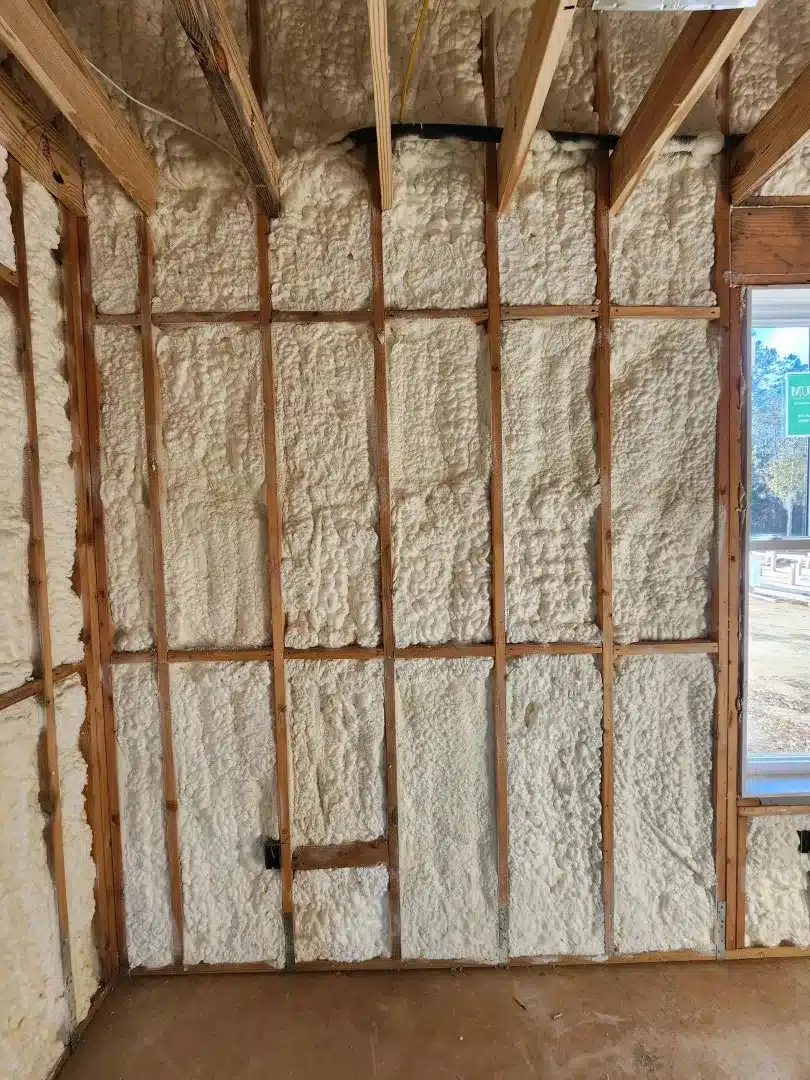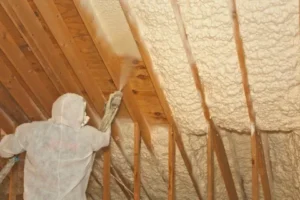Open-cell spray foam insulation works well for many Heyburn homes because of the region’s dry climate and moderate temperature swings. It provides excellent air sealing, sound dampening, and a good R-value for the cost. However, it’s not ideal for extremely humid areas of your home, like bathrooms without proper ventilation or in crawl spaces, where moisture might be an issue.
The decision depends on your specific home needs. Open-cell foam offers R-3.5 to R-3.7 per inch, costs 30-40% less than closed-cell alternatives, and creates a quieter home environment. For most Heyburn living spaces above ground, open-cell foam provides excellent value and performance.
Types of Spray Foam Insulation
Understanding the differences between open-cell and closed-cell spray foam helps you make an informed decision for your Heyburn home.
| Feature | Open-Cell Spray Foam | Closed-Cell Spray Foam |
|---|---|---|
| Density | Lower (0.5-0.6 lb/cubic ft) | Higher (1.7-2.0 lb/cubic ft) |
| R-value per inch | 3.5-3.7 | 6.0-7.0 |
| Air barrier | Yes | Yes |
| Vapor barrier | No | Yes (at 2+ inches) |
| Sound reduction | Excellent | Good |
| Water resistance | Poor | Excellent |
| Typical cost | $0.35-0.55 per board foot | $1.00-1.50 per board foot |
| Expansion | High (100x initial volume) | Low (30-40x initial volume) |
| Flexibility | Remains flexible | Rigid when cured |
Bonus Tip: For attics and interior walls in Heyburn’s climate, open-cell foam often provides the best value, as you get excellent air sealing and sound dampening at a lower cost.
Technical Specifications for Open-Cell Spray Foam
This table provides the technical details of open-cell spray foam to help you understand its performance characteristics.
| Property | Typical Value | Notes |
|---|---|---|
| R-value | 3.5-3.7 per inch | Requires greater thickness to match closed-cell R-value |
| Air permeance | <0.02 L/s/m² at 75 Pa | Excellent air sealing capabilities |
| Water vapor permeance | 5-20 perms | Allows walls to “breathe” |
| Sound Transmission Class (STC) | Improves by 8-10 points | Significantly reduces noise transmission |
| VOC emissions | Low/Minimal after curing | Most are safe for occupied spaces after 24-48 hours |
| Fire rating | Class I fire rating available | With proper fire retardants added |
| Typical application thickness | 3-12 inches | Depending on R-value needs |
| Cure time | 24-48 hours | Until safe for occupancy |
| Expected lifespan | 80+ years | When properly installed |
Benefits of Open-Cell Spray Foam for Heyburn Homes
Open-cell spray foam offers several advantages that make it particularly suitable for homes in Heyburn’s climate conditions.
Superior Air Sealing
Open-cell spray foam expands to fill cavities, gaps, and cracks completely. This comprehensive air seal:
- Reduces energy loss by up to 40% compared to traditional insulation
- Prevents dust and allergens from entering your home
- Creates a more consistent indoor temperature
- Reduces strain on your HVAC system
Excellent Sound Dampening
The soft, sponge-like structure of open-cell foam absorbs sound waves rather than reflecting them.
- Reduces outdoor noise penetration by up to 80%
- Creates quieter interior spaces between rooms
- Particularly effective for home theaters, bedrooms, and home offices
Cost-Effective Long-Term Solution
While initial installation costs exceed traditional insulation:
- Energy savings typically recover costs within 3-5 years
- According to market data, homes with spray foam insulation often sell for 5-7% more than those with traditional insulation
- Reduces HVAC equipment size requirements for new construction
Things to Consider Before Making a Decision
Before choosing open-cell spray foam for your Heyburn home, evaluate these important factors:
Climate Considerations
Heyburn’s climate features:
- Hot, dry summers
- Cold winters with moderate humidity
- Significant day-to-night temperature swings
These conditions generally favor open-cell foam for most applications above ground level.
Installation Areas
Consider where you plan to install the insulation:
- Attics and roof decks: Open-cell works well but needs proper thickness
- Exterior walls: Excellent choice in most cases
- Basement walls: May require closed-cell depending on moisture levels
- Crawl spaces: Often better suited for closed-cell foam
Budget Constraints
Factor in:
- Initial installation costs vs. long-term energy savings
- Total project square footage
- Current insulation status (removal needs)
- Any necessary prep work
Bonus Tip: Combining open-cell foam in walls and ceilings with closed-cell in moisture-prone areas often provides the best performance-to-cost ratio.
Professional Installation Requirements
Spray foam isn’t a DIY project:
- Requires specialized equipment and training
- Improper installation can reduce effectiveness and create problems
- Professional installation ensures proper expansion, coverage, and safety
Common Questions About Open-Cell Spray Foam
How Long Does Open-Cell Spray Foam Last?
When properly installed, open-cell spray foam typically lasts for the lifetime of the building (80+ years). It doesn’t settle, sag, or degrade under normal conditions.
Does Open-Cell Foam Create Moisture Problems?
In most Heyburn homes, open-cell foam works well because of the relatively dry climate. However, in extremely humid areas like poorly ventilated bathrooms or below-grade spaces, its vapor-permeable nature may not be ideal. These areas might benefit from closed-cell foam instead.
Is Open-Cell Spray Foam Safe?
Once cured (typically 24-48 hours after installation), open-cell spray foam is inert and safe for most people. During installation, installers wear protective equipment, and occupants should vacate the premises until the foam has fully cured.
Can Open-Cell Foam Reduce My Energy Bills?
Most Heyburn homeowners report 20-40% energy savings after upgrading to open-cell spray foam insulation from traditional fiberglass or cellulose. Actual savings depend on previous insulation condition, home design, and personal energy usage patterns.
Bonus Tip: Combining open-cell spray foam insulation with air sealing of other penetrations (like outlets, light fixtures, and plumbing entries) maximizes energy efficiency improvements.
FAQ
Can open-cell spray foam be installed in existing walls?
Yes, installation in existing walls is possible through small holes that are later patched. However, this approach may provide less complete coverage than installation during new construction or renovation.
How does open-cell spray foam compare to fiberglass insulation?
Open-cell foam provides superior air sealing, doesn’t settle over time, and typically delivers 20-40% better energy performance than fiberglass, though at a higher initial cost.
Will open-cell spray foam help with my allergies?
Many homeowners report reduced allergy symptoms after spray foam installation because it creates an air barrier that blocks dust, pollen, and other allergens from entering through walls and attics.
Is open-cell spray foam environmentally friendly?
Modern open-cell foams use water as the blowing agent rather than harmful HFCs. Many formulations have low VOC emissions and contribute to energy efficiency, reducing overall environmental impact.
Does open-cell spray foam repel pests?
While not specifically designed as pest control, the seamless barrier created by spray foam eliminates many entry paths for insects and rodents, potentially reducing pest problems.
Ready to Improve Your Home’s Comfort and Efficiency?
Open-cell spray foam provides best insulation for Heyburn homes, with superior air sealing, sound dampening, and energy efficiency. For typical above-grade applications in Heyburn’s climate, open-cell foam delivers excellent performance at a more affordable price than closed-cell alternatives.
Apply these insights now: Schedule your free home insulation assessment with Valley Spray Works. Discover how open-cell spray foam can transform your home’s comfort and efficiency.
Valley Spray Works (208) 490-9260 [email protected]
Reviewer:
Emily Martinez has 12 years of experience in spray foam insulation. She reviewed this article and suggested ways to make the content more useful for contractors looking to grow their customer base.

